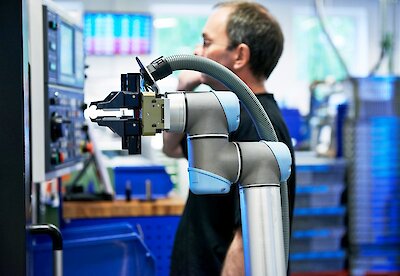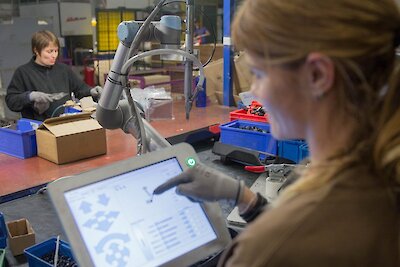By Mark Gray, Country Manager UK&I, Universal Robots
 Collaborative Robots (cobots) have the potential to transform a company’s operations and boost competitiveness. From packaging and palletising, to sanding and welding, cobots can take on a variety of labour-intensive tasks, boosting a company’s productivity and output. However, many small and mid-size enterprises (SMEs) are reluctant to take the leap and begin implementing automation.
Collaborative Robots (cobots) have the potential to transform a company’s operations and boost competitiveness. From packaging and palletising, to sanding and welding, cobots can take on a variety of labour-intensive tasks, boosting a company’s productivity and output. However, many small and mid-size enterprises (SMEs) are reluctant to take the leap and begin implementing automation.
This is due to perceptions that automation is costly, requires specialised personnel and takes up too much floor space. While there are some smaller businesses that accept automation is necessary to remain competitive, they are hesitant to implement any changes because of concerns that it’s too risky and requires a large investment with a long payback period. Yet, these common misconceptions couldn’t be further from the truth, as cobots are engineered for businesses of all sizes and needs.
COVID-19 has produced one of the most economically volatile periods in living memory, and cobots can help weather the storm but SMEs can no longer afford to view automation as a luxury.
Immediate returns on your investment
During these uncertain times, many SMEs are understandably reluctant to take risks and invest in new technologies and new ways of working. But contrary to popular belief, implementing this type of automation has all the benefits of advanced robotic automation – with none of the extra costs associated with it. In fact, a cobot typically costs less than an average employee’s annual wage, and with leasing options available, SMEs can choose to pay monthly instead of paying an upfront cost.
Similarly, cobots don’t require complex robot programming, lengthy set-up times or even having to re-organise the whole production line to allow for shielded work cells. In fact, setting up a conventional industrial robot can take weeks, whereas setting up and programming cobots takes a matter of hours – and once programmed, the cobot can immediately begin working to return your investment.
Safeguard your employees
 Where conventional, industrial robots require a lot of space for safety setups, such as separate enclosures, cobots are specifically designed to work alongside human employees and share the same workspace. In fact, the majority of our cobots operating across the globe do so with no need for safety guards. Not only this, but cobots can help reduce accidents and injuries in the production line. By taking on any strenuous and demanding physical tasks, they can ensure human employees are protected and the risk of workplace injury is greatly reduced.
Where conventional, industrial robots require a lot of space for safety setups, such as separate enclosures, cobots are specifically designed to work alongside human employees and share the same workspace. In fact, the majority of our cobots operating across the globe do so with no need for safety guards. Not only this, but cobots can help reduce accidents and injuries in the production line. By taking on any strenuous and demanding physical tasks, they can ensure human employees are protected and the risk of workplace injury is greatly reduced.
Furthermore, the most commonly held belief about automation is that it will lead to widespread job losses. But this simply isn’t the case, as cobots are designed to augment human employees – not replace them. Cobots can take on dull, dirty and dangerous tasks, allowing human employees to deploy their skills elsewhere in more valuable areas, such as strategic operations or areas which require creativity.
So cobots need to be viewed as a tool to make employees’ lives easier and improve working conditions. As many businesses that use cobots have been able to increase their workforce due to increased productivity, profits and quality.
Make flexibility a priority
The central benefit of collaborative robots is that they help build agility and flexibility into an organisation. Which are important traits in such an unpredictable marketplace, this is also particularly important for SMEs, which often have small production batches and require rapid changeovers to keep up with market demand. So industrial-scale automation can actually limit smaller manufacturers, due to the time it takes to re-programme and redeploy. In contrast, cobots are lightweight and space saving and they can be redeployed to different locations to help manufacturers become more agile.
A new task typically takes around 30 minutes to set up, which is perfect for short-production runs. Once programmed, a new task can be saved to the job files, and once a program has been written, it can be reused or edited at any time.
Automate to stay competitive
SMEs that do not start exploring automation risk being left behind as the industry moves towards wider adoption. Therefore, it’s crucial that SMEs take this important first step towards fully automated operations, to become more agile, resilient and profitable.
Download the eBook here.

